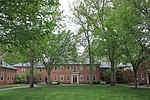Difficult Run

Difficult Run is a 15.9-mile-long (25.6 km) tributary stream of the Potomac River in Northern Virginia in the United States. The area has had many historical uses dating back to the early 1800s. Today, the area is used recreationally by visitors interested in the watershed's variety of options including hiking, biking, fishing, boating, climbing, and bird watching. The wildlife at Difficult Run is vast as 163 different species can be seen depending on the season. There are 41 different soil types found on the trail and alongside the stream. The stream is part of the greater 57.7- square-mile Drainage basin, or watershed, located in the north-central portion of Fairfax County and drains directly to the Potomac River. Difficult Run flows through Fairfax County to Great Falls Park, on the Virginia side of the Potomac River. The portion of the run through the park has been characterized as "a miniature Mather Gorge and Great Falls." The stream picks up speed as it narrows into a steep gorge with waterfalls and quickly reaches the same level as the Potomac. At the mouth of Difficult Run, one can see a panoramic view of the Potomac River.
Excerpt from the Wikipedia article Difficult Run (License: CC BY-SA 3.0, Authors, Images).Difficult Run
Difficult Run Trail,
Geographical coordinates (GPS) Address Nearby Places Show on map
Geographical coordinates (GPS)
| Latitude | Longitude |
|---|---|
| N 38.976111111111 ° | E -77.235 ° |
Address
Difficult Run Trail
Difficult Run Trail
22102
Virginia, United States
Open on Google Maps







